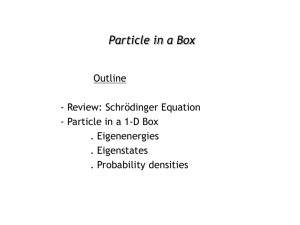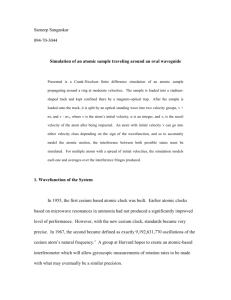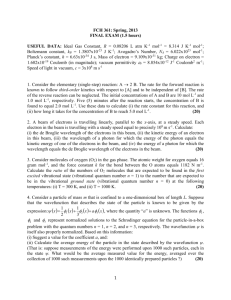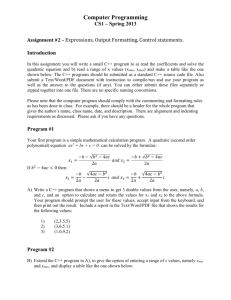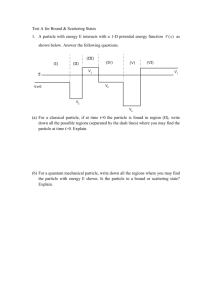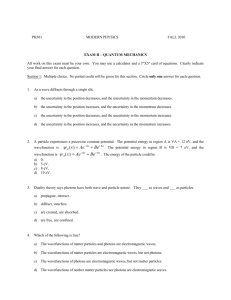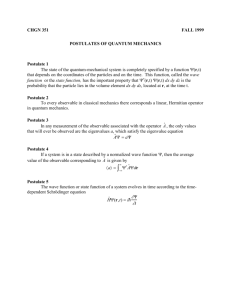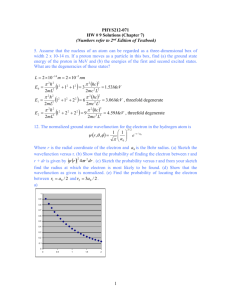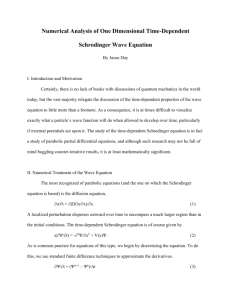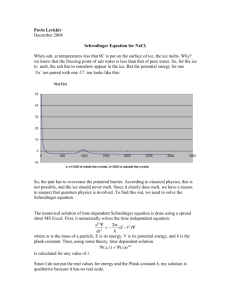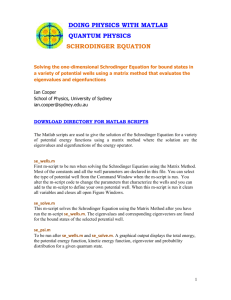qp_se_fdm - School of Physics
advertisement
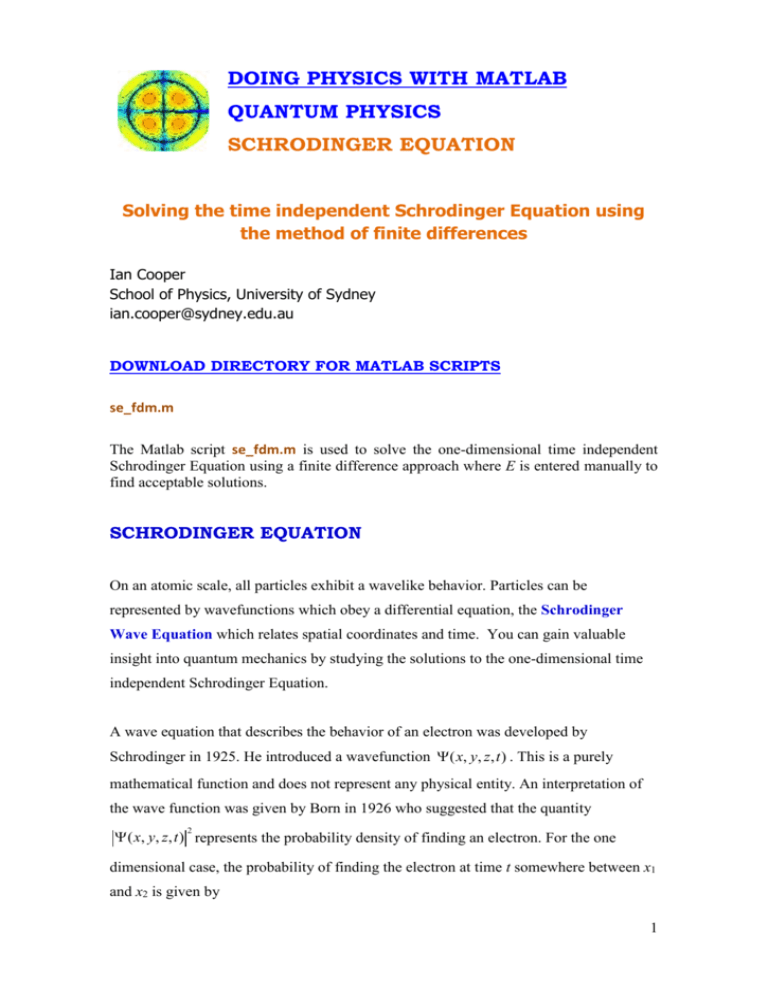
DOING PHYSICS WITH MATLAB QUANTUM PHYSICS SCHRODINGER EQUATION Solving the time independent Schrodinger Equation using the method of finite differences Ian Cooper School of Physics, University of Sydney ian.cooper@sydney.edu.au DOWNLOAD DIRECTORY FOR MATLAB SCRIPTS se_fdm.m The Matlab script se_fdm.m is used to solve the one-dimensional time independent Schrodinger Equation using a finite difference approach where E is entered manually to find acceptable solutions. SCHRODINGER EQUATION On an atomic scale, all particles exhibit a wavelike behavior. Particles can be represented by wavefunctions which obey a differential equation, the Schrodinger Wave Equation which relates spatial coordinates and time. You can gain valuable insight into quantum mechanics by studying the solutions to the one-dimensional time independent Schrodinger Equation. A wave equation that describes the behavior of an electron was developed by Schrodinger in 1925. He introduced a wavefunction ( x, y, z, t ) . This is a purely mathematical function and does not represent any physical entity. An interpretation of the wave function was given by Born in 1926 who suggested that the quantity ( x, y, z, t ) represents the probability density of finding an electron. For the one 2 dimensional case, the probability of finding the electron at time t somewhere between x1 and x2 is given by 1 (1) x2 Prob(t ) ( x, t ) * ( x, t ) dx x1 where * is the complex conjugate of the wavefunction . The value of Prob(t) must lie between 0 and 1 and so when we integrate over all space, the probability of finding the electron must be 1. ( x, t ) * ( x, t ) dx 1 In this instance the wavefunction is said to be normalized. We can see how the time-independent Schrodinger Equation in one dimension is plausible for a particle of mass m, whose motion is governed by a potential energy function U(x) by starting with the classical one dimensional wave equation and using the de Broglie relationship Classical wave equation 2 ( x, t ) 1 2 ( x, t ) 2 0 x 2 v t 2 Momentum (de Broglie) p mv Kinetic energy K 12 m v 2 Total energy E K ( x) U ( x) Wavefunction ( x, t ) ( x) ei t periodic in time for t coordinate h k Combining the above relationships, the time-independent Schrodinger Equation in one dimension can be expressed as (2) d 2 ( x) U ( x) ( x) E ( x) 2m dx 2 2 Our goal is to find solutions of this form of the Schrodinger Equation for a potential energy function which traps the particle within a region. The negative slope of the potential energy function gives the force on the particle. For the particle to be bound the force acting on the particle is attractive. The solutions must also satisfy the boundary conditions for the wavefunction. The probability of finding the particle must be 1, therefore, the wavefunction must approach zero as the position from the trapped region increases. The imposition of the boundary conditions on the wavefunction results in a discrete set of values for the total energy E of the particle and a corresponding 2 wavefunction for that energy, just like a vibrating guitar string which has a set of normal modes of vibration in which there is a harmonic sequence for the vibration frequencies. The Schrodinger Equation can be solved analytically for only a few forms of the potential energy function. In this paper we will consider the finite difference method in which the second derivative is approximated as a difference formula. FINITE DIFFERENCE METHOD One can use the finite difference method to solve the Schrodinger Equation to find physically acceptable solutions. One can also use the Matlab ode functions to solve the Schrodinger Equation but this is more complex to write the m-script and not as versatile as using the finite difference method. The finite difference method allows you to easily investigate the wavefunction dependence upon the total energy. The ‘heart’ of the finite difference method is the approximation of the second derivative by the difference formula (3) d 2 ( x) ( x x) 2 ( x) ( x x) dx 2 x 2 and the Schrodinger Equation is expressed as (4) d 2 ( x) k ( x ) 2 ( x) dx 2 2m k ( x) 2 E U ( x ) We will consider an electron trapped in a potential well of width L and depth U0 as shown in Figure 1. In regions where E > U(x), k(x) is real and ( x) has a sinusoidal shape and this corresponds to the classical allowed region (kinetic energy K > 0). In regions where E < U(x), k(x) is imaginary and ( x) has an exponential increasing or decreasing nature and this corresponds to the classical forbidden (kinetic energy K < 0). The function d 2 is the curvature of the wavefunction and its negative is a measure of dx 2 the kinetic energy of the particle (Figure 1). 3 classical allowed region energy U=0 E> U K>0 U(x) U(x) positive curvature negative curvature 0 positive curvature E E< U K < 0 E= K + U E< U K < 0 ( x) U = -U0 classical forbidden region position x classical forbidden region curvature d 2 dx 2 K .E. Fig. 1. Potential well defined by the potential energy function U(x). The bound particle has total energy E and its wavefunction is ( x) . You can use a shooting method to find E that satisfies both the Schrodinger Equation and the boundary conditions. We start with ( xmin ) 0 and a given value for E and solve the Schrodinger Equation. The value of E is increased or decreased until the other boundary condition, ( xmax ) 0 is satisfied. If the end boundary condition at x = xmax is not satisfied then the wavefunction will exponentially diverge ( x xmax ( x) ). When a solution is found, the wavefunction decreases exponentially towards the zero as shown in Figure 2. Fig. 2. Physically acceptable solutions are found only when the wavefunction ( x) converges to zero at the extreme values of x. The depth of the well is -400 eV and the width 0.1 nm. [se_fdm.m]. 4 The process of finding physically acceptable values for E and the corresponding wavefunctions ( x) can be automated by counting the number of zero crossing of the wavefunction and adjusting the value of E until the condition ( xmax ) 0 is satisfied. For the lowest energy state (ground state) E1, the wavefunction is zero only at the extreme values for x and therefore, the number of crossing is zero. The 1st excited state E2 will have only 1 crossing and the nth excited state En+1 will have n crossings as shown in Figure 3. In the Finite Difference Method, we start with x x 1 , x 2 , , x N k k 1 , k 2 , , k N where N is the maximum number of x coordinates, x(1) = xmin and x(N) = xmax ( xmin ) x(1) 0 and x(2) x(1) x 1 then as x is incremented, the other values of ( x) are calculated from the equation xc1 2 (kc x xc xc1 for c = 2 to N-1 2 When a physically accepted solution is found for the nth state the wavefunction is normalized by numerically integrating the wavefunction using Simpson’s 1/3 rule x( N ) x (1) 2 ( x) dx An n ( x) ( x) An The m-script se_fdm.m was used to find the total energies and its corresponding wavefunctions for a potential well of depth -400 eV and width 0.1 nm. The range for the x-coordinates was from -0.1 nm to + 0.1 nm. The value of E was manually adjusted to find the physically acceptable solutions as shown in Figure 3. For this potential well, there are four bound states. The total energy for the ground state, n = 1 is E 1 = -373.84 eV. Thus, the binding energy of the electron or its ionization energy (energy need to free the electron from its bound state) is EB = +373.84 eV. 5 ground state n = 1, E1 = -373.84 eV 2 nd excited state n = 3, E3 = -173.5 eV 1 st excited state n = 2, E2 = -296.63 eV 3 nd excited state n = 4, E4 = -21 eV Fig. 3. The four states for an electron confined by a potential well of depth -400 eV and width 0.10 nm with xmin = -0.10 nm, xmax = +0.10 nm. [se_fdm.m] The smaller binding energy, the less accurate are the results because the range of x values is not large enough to accurately define the exponential convergence to zero of the wavefunctions as x approaches xmax. For the case n = 4 as shown in Figure 3, E4 = 21 eV when xmax = 0.1 nm and one can see that the exponential tail is not very well defined. When xmax is increased to 0.2 nm, the exponential tail is better defined and the total energy is E4 = -24.85 eV. Solutions of the Schrodinger Equation depend upon the width of the well and the range of x values. One has to make a judgment based upon the variation of (x) as x approaches xmax in determining the most suitable range for the x values. Figure 4 shows the ground state, for the potential well of depth -400 eV and width 0.10 nm when xmax is increased from 0.10 nm to 0.20 nm. It is now more difficult to find the total energy for this state since slight variations in E result in exponential diverging tails. 6 E = - 373.797300 eV E = - 373.797386 eV E = - 373.797396 eV Fig. 4. The potential well has a depth -400 eV and width 0.01 nm. The x values range from -0.2 nm to + 0.2 nm. The wavefunction (x) is more sensitive to the total energy E as the range of x values is increased. [se_fd.m]. Running the se_fdm.m script In the Command Window type se_fdm to run the program. The following text is displayed Enter a value of E so that psi(end) = 0 default value = -295 To end the App enter a positive number eg 9 E= Inputting a positive number will terminate the program. On entering a negative number the following is displayed E = -295 No. of crossing for psi = 2 End value of psi = 2.29e+05 Continuing entering a value for E until psi(end) 0. This will then give you a physically acceptable solution of the Schrodinger Equation. 7
